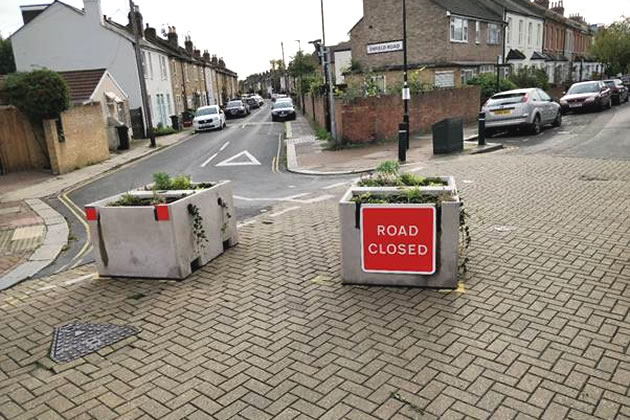Borough's LTNs Under Scrutiny as Suppressed Research Emerges
Study shows that schemes are not reducing car use

Council has implemented a number of access restrictions across the borough
September 20, 2025
Revelations that Transport for London (TfL) withheld research suggesting Low Traffic Neighbourhoods (LTNs) do not reduce car use have reignited debate across Hounslow, with growing pressure for a borough-wide review—including single point access restrictions in Brentford such as at Swyncombe Avenue.
The unpublished study, known as the Travel and Places project, was led by Professor Rachel Aldred at the University of Westminster and surveyed over 4,500 Londoners. While the research found LTNs encouraged cycling, it showed no significant reduction in car use or walking levels, suggesting traffic was displaced rather than diminished. Internal emails obtained by The Times revealed TfL officials considered the findings “underwhelming” and ultimately cut funding before publication.
In Brentford, the Swyncombe Avenue restriction has long been a point of contention. Residents have raised concerns about diverted traffic onto surrounding roads, including Boston Manor Road and Windmill Road, with some reporting increased congestion and longer journey times.
Councillor Joanna Biddolph, referencing the suppressed data, said, “Devonshire Road and other LTNs in the borough—including Swyncombe Avenue in Brentford—need to be reviewed. There has been too much denial of the realities.”
The controversy has prompted renewed scrutiny of the broader approach to LTNs. Since 2020, the council has implemented multiple schemes under its Liveable Neighbourhoods programme, citing goals of reducing through-traffic, improving air quality, and encouraging active travel. While some schemes were introduced under emergency COVID-19 powers, others—such as the South Chiswick Liveable Neighbourhood (SCLN)—have been formalised despite ongoing opposition.
Councillor Gabriella Giles (Chiswick Riverside) criticised the South Chiswick scheme for failing to address key transport challenges, stating, “None of the main problem areas—such as the A4 crossing, Grove Park Bridge, and the A316—were tackled. Much of the area isn’t served by public transport, and residents were repeatedly told this would ‘make lives better’ despite clear evidence to the contrary.”
Councillor Peter Thompson, Leader of the Conservative Group on Hounslow Council, added, “Encouraging cycling is good and something we should welcome. But residents were told LTNs would also cut car use and improve air quality. Now we learn that officials had evidence showing this isn’t true and tried to cover it up. That is unacceptable.”
Hounslow Council’s current policy supports LTNs as part of its wider transport strategy, which includes commitments to reduce emissions, promote walking and cycling, and improve road safety. However, the council has also stated that schemes remain under review and subject to community feedback. In Brentford, this has included adjustments to signage and enforcement following complaints about fines and access restrictions.
At the London level, Mayor Sadiq Khan has consistently defended LTNs, claiming they reduce traffic and improve air quality. Critics are now calling for him to clarify his role in TfL’s decision not to publish the University of Westminster study. As Chair of the TfL Board, he faces calls for a full investigation into the handling of the research.
Keith Prince, Conservative transport spokesman at City Hall, told the Local Democracy Reporting Service, “Sadiq Khan has spent years telling us LTNs cut traffic use and now it turns out covered-up data suggests otherwise. He needs to correct the record, immediately.”
TfL paid £82,000 for the research but halted the project after reviewing the second year’s findings. A spokesperson said, “We concluded that the data didn’t offer sufficient new insights to justify further investment in continuing the survey. We remain confident that LTNs can reduce traffic levels in the area, making streets safer and enabling more walking and cycling.”
The Mayor’s office was contacted for comment but had not responded at the time of publication.
Written with contributions from Kumail Jaffer – Local Democracy Reporter
Like Reading Articles Like This? Help Us Produce More This site remains committed to providing local community news and public interest journalism. Articles such as the one above are integral to what we do. We aim to feature as much as possible on local societies, charities based in the area, fundraising efforts by residents, community-based initiatives and even helping people find missing pets. We've always done that and won't be changing, in fact we'd like to do more. However, the readership that these stories generates is often below that needed to cover the cost of producing them. Our financial resources are limited and the local media environment is intensely competitive so there is a constraint on what we can do. We are therefore asking our readers to consider offering financial support to these efforts. Any money given will help support community and public interest news and the expansion of our coverage in this area. A suggested monthly payment is £8 but we would be grateful for any amount for instance if you think this site offers the equivalent value of a subscription to a daily printed newspaper you may wish to consider £20 per month. If neither of these amounts is suitable for you then contact info@neighbournet.com and we can set up an alternative. All payments are made through a secure web site. One-off donations are also appreciated. Choose The Amount You Wish To Contribute. If you do support us in this way we'd be interested to hear what kind of articles you would like to see more of on the site – send your suggestions to the editor. For businesses we offer the chance to be a corporate sponsor of community content on the site. For £30 plus VAT per month you will be the designated sponsor of at least one article a month with your logo appearing if supplied. If there is a specific community group or initiative you'd like to support we can make sure your sponsorship is featured on related content for a one off payment of £50 plus VAT. All payments are made through a secure web site. |